Queen Elizabeth-class aircraft carrier
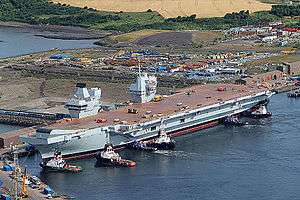 Queen Elizabeth fitting out at Rosyth in July 2014 | |
| Class overview | |
|---|---|
| Name: | Queen Elizabeth class aircraft carrier |
| Builders: | |
| Operators: |
|
| Preceded by: | Invincible class |
| Cost: | £6.2bn budget for both ships.[1] |
| In commission: |
|
| Building: | 1 |
| Planned: | 2 |
| Completed: | 1 |
| Active: | 0 |
| General characteristics | |
| Type: | Aircraft carrier |
| Displacement: | 70,600 tonnes (69,500 long tons; 77,800 short tons)[5][6][7] |
| Length: | 280 m (920 ft)[8] |
| Beam: |
|
| Draught: | 11 m (36 ft) |
| Decks: | 16,000 m2 (170,000 sq ft) 9 decks beneath flightdeck with hangar covering the centrepiece of two decks (without islands) |
| Installed power: |
|
| Propulsion: |
Full integrated electric propulsion
4 × Converteam 20 MW Advanced Induction Motors Two shafts; fixed pitch propellers |
| Speed: | In excess of 25 knots (46 km/h; 29 mph) |
| Range: | 10,000 nautical miles (19,000 km; 12,000 mi) |
| Troops: | 250[9] to 900[10] |
| Complement: | 679 crew, not including air element; total berths for up to 1,600 |
| Sensors and processing systems: |
|
| Armament: |
|
| Aircraft carried: |
|
| Aviation facilities: |
|
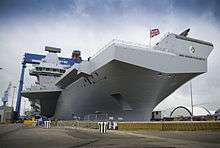
The Queen Elizabeth class is a class of two supercarriers currently under construction for the Royal Navy. The first, HMS Queen Elizabeth, was named on 4 July 2014, with her ship commissioning planned for 2017,[2] and an initial operating capability expected in 2020. The second, HMS Prince of Wales, is scheduled to be launched around 2017, followed by commissioning in 2020 and service thereafter. On 5 September 2014, at the NATO 2014 Wales summit, the Prime Minister announced that the second carrier will be brought into service, ending years of uncertainty surrounding its future. Confirmed by the November 2015 Government Strategic Defence Review, with both carriers entering service, one being made available at any time. [7][13]
The contract for the vessels was announced on 25 July 2007, by the then Secretary of State for Defence, Des Browne, ending several years of delay over cost issues and British naval shipbuilding restructuring. The contracts were signed one year later on 3 July 2008, after the creation of BVT Surface Fleet through the merger of BAE Systems Surface Fleet Solutions and VT Group's VT Shipbuilding, which was a requirement of the UK Government.
The vessels currently have a displacement of approximately 70,600 tonnes (69,500 long tons), but the design anticipates growth over the lifetime of the ships.[5] The ships will be 280 metres (920 ft) long and have a tailored air group of up to forty aircraft (though are capable of carrying up to fifty at full load).[12] They will be the largest warships ever constructed for the Royal Navy. The projected cost of the programme is £6.2 billion.[1]
Both carriers will be completed as originally planned, in a Short Take-Off and Vertical Landing (STOVL) configuration, deploying the Lockheed Martin F-35B. Following the 2010 Strategic Defence and Security Review, the British government had intended to purchase the F-35C carrier version of this aircraft, and adopted plans for Prince of Wales to be built to a Catapult Assisted Take Off Barrier Arrested Recovery (CATOBAR) configuration. After the projected costs of the CATOBAR system rose to around twice the original estimate, the government announced that it would revert to the original design on 10 May 2012.
Background
Strategic Defence Review
In May 1997, the newly elected Labour government launched the Strategic Defence Review (SDR) which re-evaluated every weapon system (active or in procurement) with the exception of the Eurofighter Typhoon and the Vanguard-class ballistic missile submarines. The report, published in July 1998, identified that aircraft carriers offer the following:[14]
- Ability to operate offensive aircraft abroad when foreign basing may be denied.
- All required space and infrastructure; where foreign bases are available they are not always available early in a conflict and infrastructure is often lacking.
- A coercive and deterrent effect when deployed to a trouble spot.
The report concluded: "the emphasis is now on increased offensive air power, and an ability to operate the largest possible range of aircraft in the widest possible range of roles. When the current carrier force reaches the end of its planned life, we plan to replace it with two larger vessels. Work will now begin to refine our requirements but present thinking suggests that they might be of the order of 30,000–40,000 tonnes and capable of deploying up to fifty aircraft, including helicopters."[14]
Design studies
The vessels, described as "supercarriers" by the media, legislators and sometimes by the Royal Navy,[7][15][16][17][18][19][20] will displace approximately 70,600 t (69,500 long tons) each,[21] over three times the displacement of its predecessor, the Invincible class. They will be the largest warships ever built in the United Kingdom.[22] The last large carriers proposed for the Royal Navy, the CVA-01 programme, were cancelled by the Labour government in 1966.[23] In November 2004, giving evidence to the House of Commons Defence Committee, First Sea Lord Admiral Sir Alan West explained that the sortie rate and interoperability with the United States Navy were factors in deciding on the size of the carriers and the composition of the carriers' air-wings:
The reason that we have arrived at what we have arrived at is because to do the initial strike package, that deep strike package, we have done really quite detailed calculations and we have come out with the figure of 36 joint strike fighters, and that is what has driven the size of it, and that is to be able to deliver the weight of effort that you need for these operations that we are planning in the future. That is the thing that has made us arrive at that size of deck and that size of ship, to enable that to happen. I think it is something like 75 sorties per day over the five-day period or something like that as well.
I have talked with the CNO (Chief of Naval Operations) in America. He is very keen for us to get these because he sees us slotting in with his carrier groups. For example, in Afghanistan last year they had to call on the French to bail them out with their carrier. He really wants us to have these, but he wants us to have same sort of clout as one of their carriers, which is this figure at 36. He would find that very useful, and really we would mix and match with that.
On 25 January 1999, six companies were invited to tender for the assessment phase of the project – Boeing, British Aerospace, Lockheed Martin, Marconi Electronic Systems, Raytheon and Thomson-CSF.[26] On 23 November 1999, the Ministry of Defence (MoD) awarded detailed assessment studies to two consortia, one led by BAe (renamed BAE Systems on 30 November 1999) and one led by Thomson-CSF (renamed Thales Group in 2000). The brief required up to six designs from each consortium with air-groups of thirty to forty Future Joint Combat Aircraft (FJCA). The contracts were split into phases; the first £5.9 million phase was for design assessment which would form part of the aircraft selection, while the second £23.5 million phase involved "risk reduction on the preferred carrier design option."[27]
Aircraft and carrier format selection
On 17 January 2001, the UK signed a Memorandum of Understanding (MoU) with the United States Department of Defense (DoD) for full participation in the Joint Strike Fighter (JSF) programme, confirming the JSF as the FJCA.[28] This gave the UK input into aircraft design and the choice between the Lockheed Martin X-35 and Boeing X-32. On 26 October 2001, the DoD announced that Lockheed Martin had won the JSF contract.[29]
On 30 September 2002, the MoD announced that the Royal Navy and Royal Air Force would operate the STOVL F-35B variant. Also announced was that the carriers would take the form of large, conventional carriers, initially adapted for STOVL operations. The carriers, expected to remain in service for fifty years, were designed for but not with catapults and arrestor wires. The carriers were thus planned to be "future proof", allowing them to operate a generation of CATOBAR aircraft beyond the F-35. Four months later on 30 January 2003, the Defence Secretary, Geoff Hoon, announced that the Thales Group design had won the competition but that BAE Systems would operate as prime contractor.[30]
When the Secretary of State for Defence announced the contract for the vessels, the cost was initially estimated at £3.9 billion.[31][32] The contracts were officially signed one year later on 3 July 2008, after the creation of BVT Surface Fleet through the merger of BAE Systems Surface Fleet Solutions and VT Group's VT Shipbuilding which was a requirement of the UK Government.[33] At the time of approval the first carrier was expected to enter service in July 2015 and the budget was £4,085m for two ships.[34] The financial crisis led to a decision in December 2008 to slow production, delaying the first ship until May 2016 and the second by two years. This decision alone added £1,560m to the cost.[34] By March 2010 the budget was estimated at £5,900m;[34] taking off the cost of capital led to a MPR10 Capital DEL baseline cost of £5,254m at this time.[35] If the carriers had been abandoned in the 2010 SDSR then the MoD could have cancelled £1.5bn of planned spending on Queen Elizabeth and £1.3bn of planned spending on Prince of Wales,[35] but the loss of VAT exemption meant that cancelling one or two carriers would have overall saved £989m and £2,098m respectively.[35] These long term savings were less important than the short term costs, there would have been nearly an extra £1bn of expenditure on cancellation costs in the FY11/12 budget.[35] In November 2013 the contract was renegotiated with a budget of £6,200m and BAE agreeing to pay 50% of any cost overruns rather than 10% as previously.[1]
Then in August 2009, speculation mounted that the UK would drop the F-35B for the F-35C model, which would have meant the carriers being built to operate conventional take off and landing aircraft using the US-designed Electromagnetic Aircraft Launch System (EMALS) catapults.[36][37]
Strategic Defence and Security Review 2010
On 19 October 2010, the government announced the results of its Strategic Defence and Security Review. The review stated that only one carrier was certain to be commissioned; the fate of the other was left undecided. The second ship of the class could be placed in "extended readiness" to provide a continuous single carrier strike capability when the other was in refit, or provide the option to regenerate more quickly to a two carrier strike ability. Alternatively, the second ship could be sold in "cooperation with a close ally to provide continuous carrier-strike capability."[38]
It was also announced that the operational carrier would have catapult and arrestor gear (CATOBAR) installed to accommodate the carrier variant of the Joint Strike Fighter rather than the short-take off and vertical-landing version.[39][40]
The decision to convert Prince of Wales to CATOBAR was reviewed after the projected costs rose to around double the original estimate. On 10 May 2012, the Defence Secretary, Philip Hammond, announced in Parliament that the government had decided to revert to its predecessor's plans to purchase the F-35B rather than the F-35C, and to complete both aircraft carriers with "ski-jumps" in the STOVL configuration.[41] The total cost of the work that had been done on the conversion to a CATOBAR configuration, and of reverting the design to the original STOVL configuration, was estimated by Philip Hammond to be "something in the order of £100 million."[42] In later testimony before a parliamentary committee, Bernard Gray, Chief of Defence Materiel, revealed that even though the carriers had been sold as adaptable and easy to convert for CATOBAR, no serious effort had been made in this direction since 2002.[43]
Strategic Defence and Security Review 2015
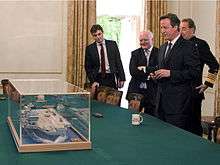
On 23 November 2015, the government published its 2015 Strategic Defence and Security Review which confirmed its plans to bring into service both Queen Elizabeth-class aircraft carriers, with one to be available at all times.[44] The review also confirmed that one of the carriers would have enhanced amphibious capabilities. The government also reaffirmed its commitment to ordering 138 F-35 Lightning IIs, although the specific variant(s) was not mentioned. The review stated that 24 of these aircraft would be available to the aircraft carriers by 2023.[44]
Design
General characteristics
_%26_HMS_Illustrious_(R_06).jpg)
The ships' company is 679 rising to 1,600 with air element added.[45] A more recent parliamentary reply stated the average crew size will be 672.[46] They will have a displacement of 65,000 tonnes on delivery, but the design allows for this to reach over 70,000 tonnes as the ship is upgraded through its lifetime.[5] They have an overall length of 280 metres (920 ft), a width at deck level of 70 metres (230 ft), a height of 56 metres (184 ft), a draught of 11 metres (36 ft) and a range of 10,000 nautical miles (12,000 mi; 19,000 km).[47] The Ministry of Defence decided not to use nuclear propulsion due to its high cost,[48] so power is supplied by two Rolls-Royce Marine Trent MT30 36 MW (48,000 hp) gas turbine generator units and four Wärtsilä diesel generator sets (two 9 MW or 12,000 hp and two 11 MW or 15,000 hp sets). The Trents and diesels are the largest ever supplied to the Royal Navy, and together they feed the low-voltage electrical systems as well as four GE Power Conversion's 20 MW Advanced Induction Motor (arranged in tandem) electric propulsion motors that drive the twin fixed-pitch propellers.[49]
Instead of a single island superstructure containing both the ship's navigation bridge and flying control (flyco) centres, the ships will have these operations divided between two structures, with the forward island for navigating the ship and the aft island for controlling flying operations.[49] Under the flight deck are a further nine decks.[50] The hangar deck measures 155 by 33.5 metres (509 by 110 ft) with a height of 6.7 to 10 metres (22 to 33 ft), large enough to accommodate up to twenty fixed and rotary wing aircraft.[49] To transfer aircraft from the hangar to the flight deck, the ships have two large lifts, each of which is capable of lifting two F-35-sized aircraft from the hangar to the flight deck in sixty seconds.[51] The ships' only announced self-defence weapons are currently the Phalanx CIWS for airborne threats, with miniguns and 30 mm cannon to counter seaborne threats.[51]
Systems
The ship's radars will be the BAE Systems and Thales[52] S1850M, the same as fitted to the Type 45 destroyers, for long-range wide-area search, the BAE Systems Artisan 3D Type 997 maritime medium-range active electronically scanned array radar, and a navigation radar.[53][54] BAE claims the S1850M has a fully automatic detection and track initiation that can track up to 1,000 air targets at a range of around 400 kilometres (250 mi).[55] Artisan can "track a target the size of a snooker ball over 20 kilometres (12 mi) away", with a maximum range of 200 km. (Artisan will also be fitted to Type 23 frigates, the assault ships HMS Albion, HMS Bulwark and HMS Ocean.)[56][57] They will also be fitted with the Ultra Electronics Series 2500 Electro Optical System (EOS) and Glide Path Camera (GPC).[58]
Munitions and ammunition handling is accomplished using a Babcock designed highly mechanised weapons handling system (HMWHS). This is a first naval application of a common land-based warehouse system. The HMWHS moves palletised munitions from the magazines and weapon preparation areas, along track ways and via several lifts, forward and aft or port and starboard. The tracks can carry a pallet to magazines, the hangar, weapons preparation areas, and the flight deck. In a change from normal procedures the magazines are unmanned, the movement of pallets is controlled from a central location, and manpower is only required when munitions are being initially stored or prepared for use. This system speeds up delivery and reduces the size of the crew by automation.[59]
Crew facilities
Crew facilities will include a cinema, physical fitness areas and four galleys manned by sixty-seven catering staff. There are four large dining areas, the largest with the capacity to serve 960 meals in one hour. There are eleven medical staff for the eight-bed medical facility, which includes an operating theatre and a dental surgery.[45] There are 1,600 bunks in 470 cabins, including accommodation for a company of 250 Royal Marines with wide assault routes up to the flight deck.[9]
Carrier air group
The vessels are expected to be capable of carrying forty aircraft, a maximum of thirty-six F-35s and four helicopters.[60] The 2010 SDSR anticipated the routine peacetime deployment of twelve F-35Bs, rising to a surge force of 24 F-35Bs and a number of helicopters.[61] Fourteen Merlin HM2 will be available[62] as a Maritime Force Protection package on the carriers with typically nine in anti-submarine configuration and five with Crowsnest for airborne early warning; alternatively a Littoral Manoeuvre package could include a mix of RAF Chinooks, Army Apaches, Royal Navy Merlin HC4 and Wildcat AH1.[61] As of September 2013 six landing spots are planned, but the deck could be marked out for the operation of ten medium helicopters at once, allowing the lift of a company of 250 troops.[61] The hangars are designed for CH-47 Chinook operations without blade folding and the V-22 Osprey tiltrotor, whilst the aircraft lifts can accommodate two Chinooks with unfolded blades.[63]
Fixed-wing aircraft
Although the size of the Queen Elizabeth class would enable it to accommodate most current and projected carrier-based fixed-wing aircraft, the lack of arresting gear means that, as initially completed, it is only capable of operating either STOVL aircraft, such as the AV-8B Harrier or F-35B Lightning, tiltrotor aircraft such as the V-22 Osprey, or aircraft that do not require either catapult assisted take-off or arrested recovery.
F-35 Lightning II
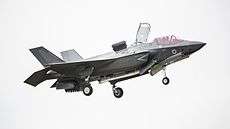
With the retirement of the Harrier GR7/9 in 2010, there remained no carrier-capable fixed-wing aircraft available to the Royal Navy or Royal Air Force.[64] Their expected replacement is the Lockheed Martin F-35 Lightning II.[65]
As originally intended, the ships will carry the STOVL version, the F-35B. The aircraft will be flown by pilots from the Fleet Air Arm and the Royal Air Force.[66] The aircraft are expected to begin trials flying from Queen Elizabeth in 2018 with a carrier air wing fully operational by 2020.[41]
For a period following the 2010 Strategic Defence and Security Review, the government had intended to purchase the F-35C carrier variant and modify one carrier to use the CATOBAR system to launch and recover these aircraft. This was because the cheaper F-35C variant has a greater range and can carry a larger and more diverse payload than the F-35B.[40][67] On 10 May 2012 Defence Secretary Philip Hammond announced in Parliament that the government had decided to revert to its predecessor's plans to purchase the F-35B rather than the F-35C, and to abandon the completion of Prince of Wales to a CATOBAR configuration.[41] The reason given was that "conversion to 'cats and traps' will cost about double what was originally estimated – and would not be delivered until 2023 at the earliest." On 19 July 2012, Defence Secretary Philip Hammond indicated in a speech in the United States that the UK would order an initial 48 F-35B aircraft to be operated jointly by the Royal Air Force and Fleet Air Arm.[68] In November 2015, the government announced its commitment to a full order of 138 F-35 aircraft, with 24 available for carrier duties by 2023.[44]
Although the F-35B is fully capable of performing vertical landing, in a similar fashion to the way that the Harrier and Sea Harrier operated, this method of operation places limitations on the loads that the aircraft is capable of returning to the ship with. As a consequence, to avoid the costly disposal at sea of both fuel and munitions, the Royal Navy is developing the Shipborne rolling vertical landing (SRVL) technique for its operation of the Lightning II. SRVL is a hybrid landing technique that uses the Lightning's vectored thrust capability to slow its forward speed to around 70 knots to allow it to make a rolling landing, using its disc brakes, without the need of an arrestor wire.[69]
Helicopters
Merlin
The AgustaWestland AW101 is a medium-sized multi-role helicopter. Two versions are in service with the UK armed forces, where it is known as Merlin. The utility version can carry up to twenty four troops seated or sixteen stretcher patients and the HM2 anti-submarine warfare variant has a dipping sonar and sonar-buoys, and a complete electronic warfare suite.[70]
Both versions use a common airframe, with three Rolls-Royce Turbomeca RTM322 engines, their range and endurance using only a two engine cruise option, is 750 nautical miles (1,390 km; 860 mi), or six hours. However, range can be extended further when the five underfloor fuel tanks are supplemented with auxiliary fuel tanks fitted in the cabin. Armament depends on mission, but includes anti-ship missiles, torpedoes, three door-mounted machine guns, multi-purpose rocket, cannon pods, air-to-air missiles and air-to-surface missiles.[70] At least 14 Merlin HM2s will be assigned to the carrier.[62]
Wildcat
The AgustaWestland Lynx Wildcat is scheduled to enter service with the Royal Navy in 2015.[71] The Wildcat can be equipped with several mission sensors, which can include: radar, active dipping sonar, electro-optical imaging, electronic surveillance measures and an integrated self-defence suite. The HM2 maritime version can be armed with air-to-surface missiles, torpedoes, depth charges, cannons and heavy machine guns. The aircraft has a maximum range of 520 nautical miles (960 km; 600 mi) and an endurance of four and a half hours.[72]
Airborne early warning and control
The 1982 Falklands War made clear the importance of airborne early warning and control and led to the development of the Sea King AEW2, which was succeeded by the Sea King ASaC7. This will be retired in the second half of 2018[73] and planning for its replacement was identified at an early stage as an integral part of the next-generation aircraft carrier.[74] The programme became known as the "Future Organic Airborne Early Warning" (FOAEW), and contracts were placed with BAE / Northrop Grumman and Thales in April 2001.[75] In April 2002, BAE and Northrop Grumman received a follow-on study contract for Phase II of the project, by then renamed Maritime Airborne Surveillance and Control (MASC).[76] The MASC assessment phase began in September 2005 and by May 2006 three study contracts were awarded for MASC platform and mission systems options: one to Lockheed Martin UK for a Merlin helicopter fitted with AEW mission systems, another to AgustaWestland to maintain the present Sea King ASaC7 and finally to Thales UK to upgrade the Sea King's mission systems.[49]
The 2010 SDSR delayed the project which became a competition between Thales and Lockheed to supply Crowsnest, a bolt-on sensor package that can be carried by any Merlin HM2.[73] The Thales pod is based on the Sea King's Searchwater 2000; Lockheed had intended to use a derivative of the F-35's APG-81 radar but is now believed to be using an Elta system. Both systems will begin flight trials in the summer of 2014[62] ahead of Main Gate in 2016.[73] Ten pods are planned with IOC in 2019.[73] Until the Crowsnest system is available, a small force of Sea King ASaC.7 helicopters will remain in service with 849 Naval Air Squadron after the final withdrawal of the remainder of the Royal Navy's Sea Kings.[77]
-

F-35B Lightning II
-

Merlin HM2 on HMS Illustrious
-
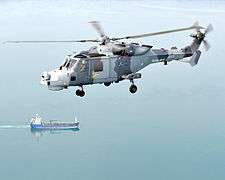
Wildcat HM2 operating over the English Channel
-

Sea King ASaC.7 flying from HMS Ark Royal
Construction

During a speech on 21 July 2004, Geoff Hoon announced a one-year delay to allow contractual and cost issues to be resolved. The building of the carriers was confirmed in December 2005. The building is being undertaken by four companies across seven shipyards, with final block integration and assembly at Rosyth:
- BAE Systems Surface Ships – Govan (Lower Blocks 3 and 4), Scotstoun (aft island) and Portsmouth (Lower Blocks 2, 5 and forward island)
- Babcock Marine – Rosyth (Sponsons, Mast and Centre Blocks 5 and 6) and Appledore (Lower Block 1)
- A&P Group – Hebburn (Centre Block 3)
- Cammell Laird – Birkenhead (Centre Blocks 2 and 4)[49]
In December 2007, eight diesel engines and electricity generators, four for each ship were ordered from Wärtsilä.[78] On 4 March 2008, contracts for the supply of 80,000 tonnes of steel were awarded to Corus Group,[49] with an estimated value of £65 million. Other contracts included £3 million for fibre optic cable, over £1 million for reverse osmosis equipment to provide over 500 tonnes of fresh water daily, and £4 million for aviation fuel systems.[79] On 3 April 2008, a contract for the manufacture of aircraft lifts (worth £13m) was awarded to MacTaggart Scott of Loanhead, Scotland.[80]
In mid May 2008, the Treasury announced that it would be making available further funds on top of the regular defence budget, reportedly allowing the construction of the carriers to begin.[81] This was followed, on 20 May 2008, by the government giving the "green light" for construction of the Queen Elizabeth class, stating that it was ready to sign the contracts for full production once the creation of the planned shipbuilding joint venture between BAE Systems and the VT Group had taken place.[82] This joint venture, BVT Surface Fleet, became operational on 1 July 2008.[83] VT Group later sold its share to BAE Systems which renamed the unit BAE Systems Surface Ships. It will undertake approximately forty per cent of the project workload.[49]
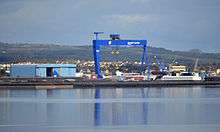
On 1 September 2008, the MoD announced a £51 million package of important equipment contracts; £34 million for the highly mechanised weapons handling system for the two ships, £8 million for supply of uptake and down-take systems for both ships, £5 million for air traffic control software, £3 million for supply of pumps and associated systems engineering, and £1 million for emergency diesel generators.[84] On 6 October 2008, it was announced that contracts had been placed for "the carriers' Rolls-Royce gas turbines, generators, motors, power distribution equipment, platform management systems, propellers, shafts, steering gear, rudders and stabilisers".[85]
The construction of the two carriers involves more than 10,000 people from 90 companies, 7,000 of them in the six shipyards building the sections of the ships.[86]
Queen Elizabeth
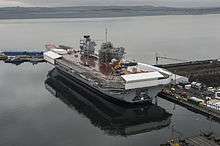
The first steel cut for the project, in July 2009, signalled the start of construction of Lower Block 3 at BAE Systems Clyde, where production of Lower Block 4 started in January 2010.[87] Meanwhile, construction of the bow Lower Block 1 was carried out at Appledore, North Devon, and was completed in March 2010.[88]
On 25 January 2010, it was announced that the Cammell Laird shipyard has secured a £44 million contract to build the flight decks of the carriers.[89] That same day, construction began in Portsmouth of the 6,000-tonne Lower Block 2 for Queen Elizabeth.[90] On 16 August 2011, the 8,000-tonne Lower Block 03 of Queen Elizabeth left BAE Systems Surface Ships' Govan shipyard in Glasgow on a large ocean-going barge. Travelling 600 miles (970 km) around the northern coast of Scotland, the block arrived at Rosyth on the evening of 20 August 2011.[91] Her forward island was built at BAE Portsmouth and attached on 14 March 2013; the aft island was attached in June 2013 and the ski jump in November 2013.[9]
Queen Elizabeth was christened on 4 July 2014,[9] and floated-out on 17 July 2014.[92] Fitting out took until the end of 2015[92] and the crew moved aboard in May 2016[9] ahead of sea trials beginning in around New Year in early 2017.[93][92] and delivery in May 2017.[92] Flight trials with helicopters will begin in 2017 and F-35B flight trials towards the end of 2018.[92] An "operational military capability" will be declared in 2020.[9]
Prince of Wales
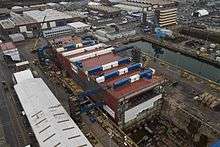
The 2010 Strategic Defence and Security Review (SDSR) declared that the UK needed only one aircraft carrier; however, penalty clauses in the contract meant that cancelling the second vessel would be more expensive than actually building it. The SDSR, therefore, directed that the second aircraft carrier, Prince of Wales, should be built but upon completion be either mothballed or sold.[94] The SDSR also directed that the ship be converted to a CATOBAR configuration; however, the costs associated with the conversion escalated to £2bn, leading the government to reverse its decision and build the ship to the original STOVL configuration.[95] On 26 May 2011, Defence Secretary Liam Fox cut the first steel for Prince of Wales.[96] The Royal Navy's 2012/13 yearbook stated "both carriers are likely to be commissioned and may even be capable of operating together".[97] In 2014, the Prime Minister, David Cameron, announced that Prince of Wales would be brought into service.[98]
As of 20 April 2016, construction of Prince of Wales was announced to be 80% complete.[99] The ship is set to be handed over to the RN in 2019 and be fully ready for front-line duties around the globe from 2023.[100]
In the period between handover and the restoration of operational Royal Navy fixed-wing capability Mark Urban speculated on the BBC programme Newsnight that both ships could 'host' USMC VSTOL aircraft.[101]
See also
References
- 1 2 3 Philip Hammond, Secretary of State for Defence (6 November 2013). "Aircraft Carriers and UK Shipbuilding". Parliamentary Debates (Hansard). House of Commons. col. 251–254.
- 1 2 "HMS Queen Elizabeth crew switch on its radar for first time". Naval Technology. Retrieved 29 August 2015.
- ↑ "Queen Elizabeth Class". Aircraft Carrier Alliance. Retrieved 14 November 2014.
- ↑ "Queen Elizabeth Class". Naval Technology. Retrieved 14 November 2014.
- 1 2 3 Harris, Stephen (27 May 2014). "Your questions answered: HMS Queen Elizabeth aircraft carrier". The Engineer.
- ↑ "Progress being made but uncertainties remain", WarShip Technology: July/Aug 2013, The Royal Institution of Naval Architects
- 1 2 3 "Queen Elizabeth class aircraft carrier: A Guide". UK Defence Journal. 3 April 2014. Retrieved 14 November 2014.
- ↑ "Queen Elizabeth Class". Royal Navy. Retrieved 21 August 2013.
- 1 2 3 4 5 6 Hargreaves, Richard (December 2013). "Asset management". Navy News. p. 8.
- ↑ "HMS Ocean:Written question – 19049". www.parliament.uk. HMG. Retrieved 16 December 2015.
- ↑ "Babcock to Deliver, Convert Phalanx 1B CIWS for Royal Navy Queen Elizabeth Aircraft Carrier". 16 December 2014.
- 1 2 Royal Navy – Global Force 2013 (PDF) (graphic), Press Association, p. 86 – source: Royal Navy.
- ↑ "UK aircraft carrier Prince of Wales to go into service". BBC. 5 September 2014. Retrieved 18 September 2014.
- 1 2 "Strategic Defence Review" (PDF). Ministry of Defence. July 1998. pp. 143–144. Archived from the original (PDF) on 26 March 2011. Retrieved 8 July 2008.
- ↑ Steel cut for second super-carrier | Royal Navy
- ↑ "Order Book Part 1: Written Questions". House of Commons. 8 September 2003. Retrieved 13 April 2015.
- ↑ Lord Luke (15 March 2007). "Armed Forces". Parliamentary Debates (Hansard). House of Lords. col. 879–881.
- ↑ Giant piece of the HMS Queen Elizabeth jigsaw slots into place | Royal Navy
- ↑ "Huge sections of new Navy carrier joined together". Ministry of Defence. 11 April 2012. Retrieved 13 April 2015.
- ↑ "Go-ahead given for work to start on supercarriers". Portsmouth News. 20 May 2008. Retrieved 23 December 2008.
- ↑ Allison, George (2 April 2014). "Queen Elizabeth class aircraft carrier: A Guide". ukdefencejournal.org.uk. Retrieved 7 August 2016.
- ↑ "HMS Queen Elizabeth". Wärtsilä. Retrieved 5 January 2012.
- ↑ James, D. R. (January 1999). "Carrier 2000: A Consideration of Naval Aviation in the Millennium – I" (PDF). The Naval Review. 87 (1): 3.
- ↑ "Examination of Witnesses". Parliamentary Debates (Hansard). House of Commons questions 520 – 539. 24 November 2004. Retrieved 30 December 2011.
- ↑ "Examination of Witnesses". Parliamentary Debates (Hansard). House of Commons questions 540 – 559. 24 November 2004. Retrieved 30 December 2011.
- ↑ Nicoll, Alexander (26 January 1999). "US companies bid for $2.5bn ships deal". Financial Times.
- ↑ "Shipyard in running for Navy contract". The Belfast Telegraph. Belfast Telegraph Newspapers. 24 November 1999.
- ↑ "Signing of U.S./U.K. Memorandum of Understanding on the Joint Strike Fighter". U.S. Department of Defense. 17 January 2001. Retrieved 1 January 2012.
- ↑ Bolkcom, Christopher. "JSF Background, Status, and Issues" (PDF). CRS Report for Congress. Archived from the original (PDF) on 2 December 2012. Retrieved 1 January 2012.
- ↑ Geoffrey Hoon, Secretary of State for Defence (30 January 2003). "Future Aircraft Carrier". Parliamentary Debates (Hansard). House of Commons. col. 1026–1028.
- ↑ Des Browne, Secretary of State for Defence (25 July 2007). "CSR and Aircraft Carriers". Parliamentary Debates (Hansard). House of Commons. col. 865–867.
- ↑ Evans, Michael (25 July 2007). "Go-ahead for £5bn aircraft carriers". The Times. London: Times Newspapers. Retrieved 26 July 2007.
- ↑ Keane, Kevin (3 July 2008). "New contract 'will secure Rosyth'". London: BBC. Retrieved 3 July 2008.
- 1 2 3 "Ministry of Defence Major Projects Report 2010 HC489-I" (pdf). House of Commons Defence Committee. 15 October 2010. p. 7 and fig 3.
- 1 2 3 4 "The Major Projects Report 2010 – Public Accounts Committee – Supplementary written evidence from the Ministry of Defence". UK Parliament. 15 February 2011. Retrieved 19 August 2014.
- ↑ "Britain rethinks jump jet order". UPI.com. 12 August 2009. Retrieved 14 August 2009.
- ↑ Harding, Thomas (5 August 2009). "Defence jobs at risk". The Daily Telegraph. London: Telegraph.co.uk. Retrieved 14 August 2009.
- ↑ "Fact Sheet 9: Carrier Strike" (PDF). HM Government. 19 October 2010. Retrieved 27 October 2010.
- ↑ "Securing Britain in an Age of Uncertainty: The Strategic Defence and Security Review" (PDF). HM Government. 19 October 2010. Archived from the original (PDF) on 22 December 2010. Retrieved 19 October 2010.
- 1 2 Hoyle, Craig (19 October 2010). "Cameron: UK to swap JSFs to carrier variant, axe Harrier and Nimrod". Flight Global. Retrieved 30 December 2011.
- 1 2 3 "Defence Secretary Announces Decision on Jets for Navy's Future Carriers". News and Events - Latest News. Royal Navy. 10 May 2012. Retrieved 10 May 2012.
- ↑ Bentley, Matt (11 May 2012). "How do you solve a problem like an expensive aircraft carrier?". fullfact.org. Retrieved 20 May 2012.
- ↑ Military; Space; Technology; Science; Nasa; Discovery, THESE ARE THE VOYAGES of the space probe; FEATURES, WATERPROOF iPhone 6Ss? Old news Check out the OTHER 7 SECRET; be?, NASA announcement of MAJOR MARS DISCOVERY imminent: WHAT can it. "The truth on the Navy carrier debacle? Industry got away with murder". theregister.co.uk. Retrieved 7 August 2016.
- 1 2 3 "National Security Strategy and Strategic Defence and Security Review 2015" (PDF). HM Government.
- 1 2 "The Queen Elizabeth Class". Aircraft Carrier Alliance. Retrieved 29 December 2011.
- ↑ Soames, Nicholas (15 October 2014). "Aircraft Carriers: Written question – No. 210756". House of Commons. Retrieved 13 April 2015.
- ↑ "Facts and figures". Royal Navy. Retrieved 31 December 2011.
- ↑ "Queen Elizabeth Class (CVF), United Kingdom". Naval-Technology.com. Retrieved 1 December 2013.
- ↑ "First steel cut for new aircraft carrier". Defence News. Retrieved 30 December 2011.
- 1 2 "Key facts" (PDF). Aircraft Carrier Alliance. Retrieved 30 December 2011.
- ↑ "Thales signs further orders". Thales.
- ↑ "Weapons and sensors" (PDF). BAE Systems. Retrieved 30 December 2011.
- ↑ "HMS Queen Elizabeth Aircraft Carrier Fitted with Thales SMART-L (S1850M) Long Range Radar". 2 December 2013.
- ↑ "S1850M Long Range Radar". BAE Systems. Retrieved 31 December 2011.
- ↑ "Navy to get new radar". Ministry of Defence. 4 August 2008. Retrieved 29 December 2011.
- ↑ "The new military radar capable of detecting a tennis ball moving at three times the speed of sound". Pocket Lint.
- ↑ "Ultra Electronics Wins Contract for EO Systems for Queen Elizabeth Class Carriers". Ultra Electronics. 9 August 2010.
- ↑ "Weapons handling system for the new aircraft carrier begins to take shape". Professional Engineering Magazine. 15 January 2011. Retrieved 3 January 2011.
- ↑ Adams, Christopher (25 July 2007). "MoD gives nod for aircraft carriers". Financial Times. Retrieved 19 September 2013.
- 1 2 3 Osborne, Anthony (11 September 2013). "UK Royal Navy Widening Scope of Carrier Use". Aviation Week.
- 1 2 3 Osborne, Tony (15 July 2014). "U.K. Considering Bringing Orphaned Merlins into Service". Retrieved 16 July 2014.
- ↑ Osborne, Anthony (30 August 2013). "UK Builds Fleet of Modernized Chinooks". Aviation Week.
- ↑ "Last Harrier takes off from HMS Ark Royal". Defence News. 24 November 2010. Retrieved 30 December 2011.
- ↑ "RAF test pilot on Lightning II". Defence News. 12 August 2010. Retrieved 30 December 2011.
- ↑ "UK's first next generation fighter". Royal Navy. 23 November 2011. Retrieved 30 December 2011.
- ↑ "The Choice of Aircraft for our Pocket Super Carriers" Sharkey's world, 3 April 2012. Retrieved 12 May 2012.
- ↑ Hewson, Robert (27 July 2012). "UK slashes F-35B numbers but might look to split buy with F-35As". Jane's. Archived from the original on 30 May 2013.
- ↑ "Lockheed gets funds for UK F-35 landing modification". flightglobal.com. Retrieved 10 June 2012.
- 1 2 "AW110". AgustaWestland. Retrieved 30 December 2011.
- ↑ "Navy's new Wildcat makes first landing at sea". Defence News. 9 November 2011. Retrieved 30 December 2011.
- ↑ "AW159". AgustaWestland. Retrieved 30 December 2011.
- 1 2 3 4 Scott, Richard (7 May 2014). "UK extends Sea King ASaC.7 life out to 2018". IHS Jane's Defence Weekly. Retrieved 16 July 2014.
- ↑ "BAE Systems and Northrop Grumman to study UK future airborne early warning concepts". BAE Systems. 2 April 2001. Retrieved 1 January 2012.
- ↑ Penney, Stewart (10 April 2001). "UK Airborne Early Warning study contracts assigned". Flight International. Reed Business Information: 16.
- ↑ "BAE Systems, Northrop Grumman Awarded Follow-On Carrier AEW Study". Defense Daily. PBI Media. 17 April 2002.
- ↑ Scott, Richard (7 May 2014). "UK extends Sea King ASaC.7 life out to 2018". IHS Jane's 360. Jane's. Retrieved 17 June 2014.
- ↑ "Britain's Future CVF Carriers: the Queen Elizabeth Class". Defense Industry Daily. 21 December 2011. Retrieved 5 January 2012.
- ↑ "80,000 Tonnes of Steel Ordered For New Aircraft Carriers". Royal Navy. 4 March 2008. Retrieved 20 May 2008.
- ↑ "Aircraft lifts ordered for new Navy carriers". Defence News. 4 April 2008. Retrieved 30 December 2010.
- ↑ Alleyne, Richard (16 May 2008). "MOD allowed funds for kit and aircraft carriers". The Daily Telegraph. London. Retrieved 20 May 2008.
- ↑ "Gov't gives go-ahead for two new aircraft carriers". AFP. 20 May 2008. Retrieved 20 May 2008.
- ↑ "BVT Surface Fleet Joint Venture becomes operational" (Press release). BAE Systems. 30 June 2008. Retrieved 1 July 2008.
- ↑ "Hi-tech weapons handling system for new aircraft carriers". Ministry of Defence. 1 September 2008. Retrieved 29 December 2011.
- ↑ "Carrier work boosts Scots firms". BBC. 6 October 2008. Retrieved 4 January 2012.
- ↑ "Design". Royal Navy. Retrieved 29 December 2011.
- ↑ "First steel cut on new carrier". The Manufacturer. 25 February 2010. Archived from the original on 11 January 2011. Retrieved 26 February 2010.
- ↑ "Bow Completed". Naval Technology. 7 April 2010. Retrieved 30 December 2011.
- ↑ "Firm wins £44m warship contract". BBC News. 25 January 2010. Retrieved 22 May 2010.
- ↑ "Construction begins at new UK carriers' base port". Defpro.News. 25 February 2010. Retrieved 6 February 2010.
- ↑ "Huge carrier block arrives in Rosyth". Navy News. 22 August 2011. Retrieved 29 December 2011.
- 1 2 3 4 5 Osborne, Tony (17 July 2014). "U.K. Carrier Floated for the First Time". Aviation Week.
- ↑ "HMS Queen Elizabeth receives first seagoing Captain". UK Defence Journal. 24 May 2016. Retrieved 7 June 2016.
- ↑ Securing Britain in an Age of Uncertainty: The Strategic Defence and Security Review (PDF), HM Government, October 2010, p. 23, ISBN 9780101794824, archived from the original (pdf) on 22 December 2010
- ↑ Philip Hammond, Secretary of State for Defence (10 May 2012). "Carrier Strike Capability". Parliamentary Debates (Hansard). House of Commons. col. 140–142.
- ↑ "First steel cut for HMS Prince of Wales". Transmission. July 2011. Retrieved 29 December 2011.
- ↑ "A Global Force 2012/13" (pdf). Royal Navy. 2013. p. 24. ISBN 978-1-906940-75-1.
- ↑ HM Government NATO Summit 2014
- ↑ "Aircraft Carriers:Written question – 33852". HM Government. 20 April 2016. Retrieved 20 April 2016.
- ↑ "Iconic structure is installed on HMS Prince of Wales".
- ↑ Urban, Mark (27 November 2014). "US squadrons 'may use UK carrier' for operations". Newsnight. Retrieved 23 April 2013 – via BBC News Portal.
External links
| Wikimedia Commons has media related to Queen Elizabeth class aircraft carriers. |
- Royal Navy – The Equipment – Aircraft Carrier (royalnavy.mod.uk)
